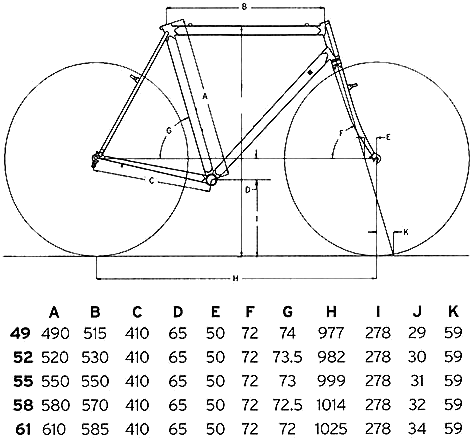
|

The 1990s were a time when decent touring bikes were very scarce in the market, probably in reactionto the excesses of the mid 1980s when the touring bike market was glutted.
The Bianchi Volpe was and remains a very nice bike, but it is no longer as unusual as it was in 1997 when this article was written. Nowadays there are many more nice touring bikes availalbe from a variety of manufacturers.
See:
The original Volpe was kind-of a faux cyclocross bike, but it has evolved into a really nice touring bike; let me tell you about it...
The tubes are butted, with an oversized downtube which is ovalized at the bottom bracket. Like most Bianchis, it uses oversized round->oval chainstays with no clearance dents. This "Superset II" construction of the drive-train area provides a very stiff, efficient drive-train area of the frame. The Volpe has horizontal dropouts (short) with adjusters, slotted cable stops on the top of the top tube for the rear brake, a slotted stop on the right chainstay for the rear derailer, a pump peg on the back of the head tube, front lowrider and rear rack eyelets, double eyelets on the fork. There is plenty of fender clearance even with the cushy Ritchey tires.
Like most Bianchi road bikes it comes with throwaway plastic pedals for test ride purposes...you are expected to buy the clipless pedals of your choice.
I would have preferred a brazed-on bridge-type cable stop for the rear brake, I really hate the klugy ones that hang off of the seatpost bolt, but lots of good bikes use them.
The front hub is some kind of Taiwan knock-off called a "Quando", with the logo arranged so that you really have to look very closely to see that it doesn't say "Shimano". I'm sure it is a decent hub, but I would rather have seen the real McCoy.
While the rear wheel was properly tensioned (120kgf) the front was rather on the soft side, 70-85 kgf. This required an extra half-turn all around to bring the spokes up to proper tension. Again, this is the sort of thing that a good mechanic will catch and correct while assembling the bike, but not all shops do this.
I would have preferred full-sized chainrings instead of the 46/36/26 microdrive setup, but that's Shimano's doing, not Bianchi's. At least the RSX crankset is the standard triple bolt circle pattern (110/74) so you can buy full sized rings for it if you wish.
| Gain Ratios | Gear Inches |
| 26 | 27.8% | 36 | 21.7% | 46 | 26 | 27.8% | 36 | 21.7% | 46 | |||
|---|---|---|---|---|---|---|---|---|---|---|---|---|
| 11 | 4.73 | 6.55 | 8.36 | 11 | 63 | 88 | 112 | |||||
| 15.4% | ||||||||||||
| 13 | 4.00 | 5.54 | 7.08 | 13 | 54 | 74 | 95 | |||||
| 13.3% | ||||||||||||
| 15 | 3.47 | 4.80 | 6.13 | 15 | 46 | 64 | 82 | |||||
| 16.7% | ||||||||||||
| 18 | 2.89 | 4.00 | 5.11 | 18 | 39 | 54 | 68 | |||||
| 14.3% | ||||||||||||
| 21 | 2.48 | 3.43 | 4.38 | 21 | 33 | 46 | 59 | |||||
| 12.5% | ||||||||||||
| 24 | 2.17 | 3.00 | 3.83 | 24 | 29 | 40 | 51 | |||||
| 14.3% | ||||||||||||
| 28 | 1.86 | 2.57 | 3.29 | 28 | 25 | 34 | 44 |

![]()
Last Updated: by Harriet Fell